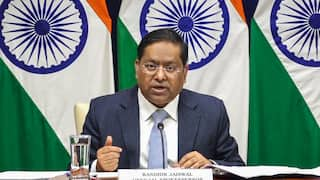Net Zero By 2070: Why India Must Focus On Transition Finance, Decoupling Emissions From Growth
Given that a period of rapid economic growth is expected between now and 2030, decoupling economic and emissions growth, and unlocking investments capable of doing that should be a priority.

Backed by a vibrant private sector, innovative technologies, and an enabling policy environment, India has made great strides in its transition towards a low-carbon economy. In June 2023, renewable energy accounted for 43.6% of total generation, tipping past its original Paris Agreement commitment of achieving 40% capacity from non-fossil fuel sources by 2030. Such is the success of this journey to date, that it is now cheaper to build a solar plant than it is to build a coal plant, which augurs well for India, as it implies economies of scale are kicking in the renewables space. Backed by supportive regulation, India has also seen impressive progress in offshore wind, energy storage capacity, and green hydrogen or ammonia. The country's decarbonisation plans are well underway with its net-zero goals seemingly on target.
Data from the International Monetary Fund and ClimateWatch shows that in 2020, India's emissions to GDP ratio was 1:1, far higher than the G-20 average of 0.44:1. However, given that a period of rapid economic growth, of around 6.7% per annum, is expected between now and 2030, decoupling economic and emissions growth would be a priority.
There are three major factors for India to consider. First, coal power's share in the energy mix remains high at 49.1% and needs to reduce while the share of renewables must increase further. Second, emissions in hard-to-abate and household sectors need to drop via demand-side energy efficiency initiatives. And third, with a proportion of the population living outside the centralised energy grid in India's hinterland, distributed renewable energy (DRE) solutions need to be scaled up to bring clean energy to millions. All this would require innovative financing and capital towards scaling up energy efficiency, renewable energy capacity, upgradations of grid network, assistance for enhanced energy access to last mile end user communities, and a just transition of workers that are affected in the process, like decommissioned coal plants.
To achieve its 2070 net zero goal, it is estimated that India requires a total finance of $10.1 trillion, consisting of $8.4 trillion for energy, $1.5 trillion for industry, and $0.2 trillion on mobility and transport. While undoubtedly an extraordinary sum, there has been growing momentum to mobilise this capital, with the estimated investment gap now at around $3.5 trillion. Therefore, the focus must now shift towards transition finance to close this gap. Doing so would decouple the country’s economic growth from emissions growth, reducing the potential risks to its economy and society from climate change.
Unlocking investments capable of decoupling emissions from growth is critical and fuelling such a transition finance intervention can be achieved by:
Leveraging innovative financing that draws in private capital at speed
Innovative tools like impact investing, credit enhancements, blended finance, or developmental assistance have worked, but not at the scale required. There is an acute need for catalytic capital or risk-cover instruments that have a proven track record of delivering on the security element that private capital needs. For example, it is estimated that $1 in investment from the Global Environment Facility can catalyse $12-15 of private investment into energy efficiency projects.
There are several proven models that have potential for replicability. These include the blended US-India Clean Energy Finance facility (USICEF) that supported 47 DRE projects in India and mobilised nearly $300 million in external debt. The scalability of such models needs to grow substantially.
Replacing direct lending with risk-mitigation mechanisms by national development banks (NDBs) and international finance institutions (IFIs) would accelerate private capital’s entry into transition finance. On the other hand, involving IFIs in consortium lending with local banks through blended mechanisms would unlock new credit assessment models. These could reduce the risk aversion of local banks, aid scalability, and unlock new credit lines.
Expanding the role of NDBs and articulating transition objectives at institutional level would further help overcome barriers faced by developing countries, such as long-tenor funding and currency risk. This would create a strong pipeline of bankable projects. Finally, expanding the RBI’s priority sector norms (PSL) to include emerging segments, like EVs, may help mobilise additional private sector capital and give direction to the industry.
Impact through performance-linked products
Finance needs to create measurable impact, and instruments with pre-defined KPIs related to emissions reduction or clean energy – like sustainability-linked loans (SLL) or sustainability-linked bonds (SLBs) – could deliver it. Verified independently by third-party evaluators, SLLs/SLBs provide additional comfort on market entry and transparency to the private sector. Despite a sharp uptick in the use of SLLs, there is significant headroom for growth in volume. Unlike green bonds, the use of SLLs and SLBs has been diverse across companies and sectors rather than restricted to a few big solar companies.
For smaller investments in DRE, energy efficiency, or smaller clean energy applications, aggregating capital with standardised impact criteria would be effective to attract investors.
Enhancing skill-sets among financial institutions to assess transition risks, opportunities
Low carbon transition involves the development of new capacity within the domestic financial sector, which manages the bulk of financial assets. While Indian-owned banks manage 96.2% of total credit, the complexity of climate sectors often inhibits capital flows due to the difficulty in structuring finance, assessing transition risks, or restricted access to risk-mitigation mechanisms. This often leads banks towards financing conventional projects that have an established risk matrix, tenure, and pricing. In short, a deeper understanding of risks at sectoral and project level is needed.
While India has picked up momentum on its transition journey, the path is long winding and steep. The priority needs to move beyond solar and onshore wind, to DRE and energy efficiency. However, this requires catalytic investments, risk-cover instruments, performance-linked financing, and capacity building in local financial institutions. A steadfast holistic approach, backed by strong policies, financing mechanisms, and capable private players is bound to accelerate India’s transition journey and balanced economic growth.
The author is the Founder and Managing Director, auctusESG.





































